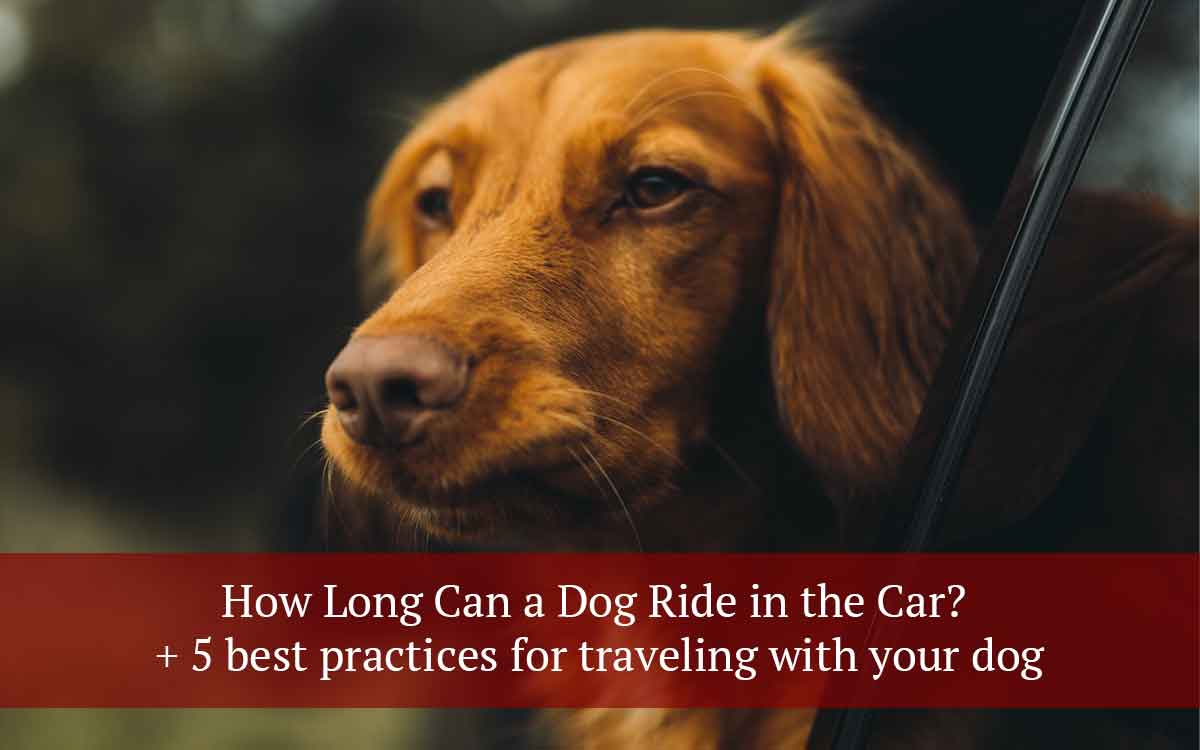It’s a common question that dog owners face: how long can I travel with my dog before they get bored or anxious? The answer to this question largely depends on the individual dog, but generally you should give your dog a break every 3 hours for about 20 to 30 minutes to make the dog feel more at ease.
In this article we would discuss some general guidelines that you can follow to ensure your dog or pup stays comfortable and entertained during your road trip. We will also discuss the different factors that play into how long a dog can ride in a car, as well as some tips for keeping them happy and occupied during the journey.
Factors that affect how long a dog can ride in a car
There are a couple of things that you need to take into account when trying to determine how long your dog can ride in the car.
- Age
- Frequency
- Size
- Breed
- Temperament
- Training
These are all important factors that will play into how long your dog can stay in the car before they need a break. Let’s explore these options in more detail.
1. Age
The first factor is age. Puppies and senior dogs are generally not able to handle long car rides as they can get easily tired or stressed. If you are planning on taking a long car trip, it is best to wait until your puppy is at least a year old before attempting it.
For senior dogs, short car rides may be all that they can handle. Just like humans, when we are too young or too old, our bodies are not able to handle long periods of sitting or standing. The same goes for dogs.
Growing up my family had a golden retriever who was the perfect car companion. He could sit for hours without getting antsy, but as he got older we noticed that he started to get restless after about 30 minutes in the car. This is not unusual for senior dogs, so if you have an elderly dog, it is best to stick to shorter car rides. I would suggest you consult with your veterinarian before taking your senior dog on a long car trip.
2. Frequency
Another factor to consider is frequency. If you only take your dog on short car rides to the vet or occasional trips to the park, It may not be used to being in the car for extended periods. In this case, it would be best to start with shorter car rides and work your way up to longer ones.
On the other hand, if you frequently take your dog on long car rides, it will likely be more comfortable and able to handle it. My dog, for example, is used to going on long car rides as we often travel to different provinces to visit family. He usually sleeps for most of the ride, but will occasionally get up to stretch his legs or have a snack.
3. Size
The next factor is size. Smaller dogs are generally able to handle long car rides better than larger dogs as they can more easily curl up and take a nap.
Larger dogs, on the other hand, may have a harder time getting comfortable in the car and may need more frequent breaks. If you have a large dog, I would suggest planning for more frequent stops so they can stretch their legs and use the restroom.
4. Breed
Another thing to consider is breed. Some breeds are more prone to car sickness than others, so if you have a breed that is known to get motion sickness, it is best to stick to shorter car rides.
Some breeds that are more prone to car sickness include:
- Pugs
- Bulldogs
- Boston Terriers
- Boxers
If you have one of these breeds, I would suggest talking to your veterinarian about what you can do to prevent car sickness. Also, I suggest you avoid feeding your dog a big meal before the car ride as this can make the symptoms worse.
5. Temperament
The final factor to consider is temperament. If your dog is generally anxious or stressed, it may not do well on long car rides. In this case, it is best to start with shorter car trips and work up to longer ones.
You may also want to consider using a calming aid such as CBD oil to help your dog relax during the car ride. If you do use a calming aid, I would suggest starting with a lower dose and seeing how your dog reacts before increasing the amount.
6. Training
One last thing to keep in mind is training. If your dog is not used to being in the car, it may not know how to behave. This can make long car rides stressful for both you and your dog.
I would suggest taking some time to train your dog on how to behave in the car before taking them on a long trip. You can start by taking them on short car rides and gradually increase the length of the trips.
You can also try using this cool K&H Pet Products Travel Safety Carrier for Pets or seatbelt to help your dog feel more secure in the car.
Remember, every dog is different and you know your dog best. Use these factors as a guide, but ultimately, it is up to you to decide how long your dog can handle being in the car.
Keep reading to learn about some best practices for safely traveling with your dog
5 Best Practices For Safely Traveling With Your Dog in the Car
There are a few things you can do to make car rides with your dog safer and more enjoyable for both of you.
Here are five best practices for safely traveling with your dog in the car:
- Always use a seatbelt or carrier
- Never leave your dog alone in the car
- Bring along their favorite toy or blanket
- Make sure they have a good view
- Stop for breaks often
Let’s explore these options in more detail.
1. Always use a seatbelt or carrier:
The safest way to travel with your dog in the car is by using a seatbelt or carrier. This will help to keep them secure in one spot and prevent them from roaming around the car, which can be distracting and dangerous. as mentioned above coolK&H Pet Products Travel Safety Carrier for Pets. This is a great option as it attaches to your seatbelt and has a built-in leash so you can easily take your dog out for potty breaks.
2. Never leave your dog alone in the car:
Another important safety tip is to never leave your dog alone in the car. This can be very dangerous, even on mild days. The temperature inside a car can rise very quickly, and your dog could suffer from heat stroke or even die.
If you want to stretch your legs or take a break whilst during a long journey, it’s best to bring your dog out of the car with you.
3. Bring along their favorite toy or blanket:
A great way to make your dog feel more comfortable during a long car ride is to bring along their favorite toy or blanket. This will help to create a sense of home for them and make the unfamiliar surroundings seem less daunting. If you don’t have enough toys for your dog you can check out these cool Zeaxuie Puppy Toys from amazon.
4. Make sure they have a good view:
Another way to help your dog feel more comfortable during a car ride is to make sure they have a good view. This can be done by putting them in a carrier that faces the front of the car or by cracking open a window so they can see outside.
Dogs love to look out the window and this can help to calm them during a car ride.
5. Stop for breaks often:
If you are taking a long car ride with your dog, it’s important to stop for breaks often. This will give your dog a chance to stretch its legs, use the restroom, and get some fresh air.
It’s also a good time for you to give them a drink of water and something to eat. I like to bring along some healthy dog treats such as these Zuke’s Natural Dog Treats that are perfect for on-the-go.
These are 5 best practices for safely traveling with your dog in the car.
Final Thought
Dogs are great companions and can make car rides a lot more fun. However, it’s important to be aware of how long your dog can handle being in the car before boredom or anxiety sets in.
By following the best practices I mentioned earlier for safely traveling with your dog in the car, you can help to make car rides more enjoyable for both of you. So next time you hit the road, keep these tips in mind!
Happy travels!
If you have any questions or comments, please feel free to reach out to me at [email protected] I’d love to hear from you!


